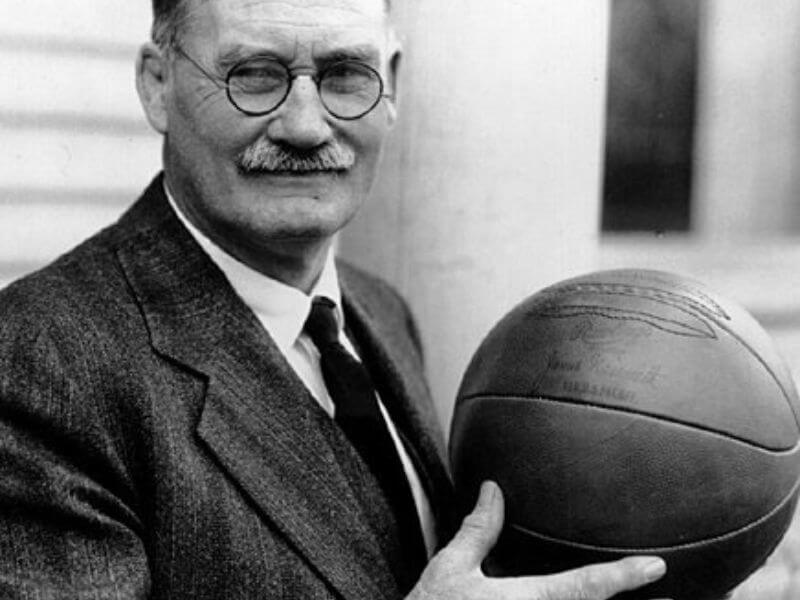Who invented basketball? Dr. Naismith had been challenged to create a new game that could be played indoors in the cold Massachusetts winters to provide an “athletic distraction” to a disruptive group of students. With a two-week deadline, Dr. Naismith decided to invent a game of skill, finesse, and accuracy, rather than one that relied on pure strength.
He was inspired by a game he had played as a child called “duck on a rock,” in which players lob a small rock at a “duck” placed on top of a large rock in an attempt to knock the “duck” off.
Using a soccer ball, two peach baskets placed 10 feet up in the air, nine players on each team, and a set of 13 basic rules, Dr. Naismith invented the game of “basket ball.” The first game was played on December 21, 1891.
Initially, players could only advance the ball by passing it. Bouncing the ball along the floor — what we call “dribbling” today — did not become part of the game until later.
Players earned points by successfully tossing the soccer ball into the peach baskets. After each basket that was made, players had to climb a ladder to retrieve the ball from the basket. Iron hoops with open-ended nets didn’t come along until 1913!

Interesting basketball facts:
Dr. Naismith was inducted into the Basketball Hall of Fame in 1959. The Basketball Hall of Fame is now called the Naismith Memorial Hall of Fame.
The first college basketball game was played on January 18, 1896, when the University of Iowa hosted a game with the University of Chicago. The final score was: Chicago 15, Iowa 12.
U.S. patent #1,718,305 was granted to G.L. Pierce on June 25, 1929, for the first version of what we now recognize as the “basketball.”
“March Madness” began in 1939, when the first NCAA tournament took place at the University of Illinois.
Basketball became an official Olympic sport at the 1936 Olympic Games in Berlin, Germany.
Naismith’s 13 original rules:The Ball may be thrown in any direction by one or both hands.
The ball may be batted in any direction with one or both hands (never with the fist).
A player cannot run with the ball. The player must throw it from the spot on which he catches it, allowance to be made for man who catches the ball when running, if he tries to stop.
The ball must be held by the hands; the arms or body must not be used for holding it.
No shouldering, holding, pushing, tripping, or striking in any way the person of an opponent shall be allowed; the first infringement of the rule by any player shall count as a foul, the second shall disqualify him until the next goal is made, or if there was evident intent to injure the person, for the whole game, no substitute allowed.
A foul is striking at the ball with the fist, violation of rules 3, 4, and such as described in rule 5.
If either side makes three consecutive fouls it shall count a goal for the opponents (consecutive means without the opponents in the meantime making a foul.)
A goal shall be made when the ball is thrown or batted from the grounds into the basket and stays there, providing those defending the goal do not touch or disturb the goal. If the ball rests on the edges, and the opponent moves the basket, it shall count as a goal.
When the ball goes out of bounds it shall be thrown into the field of play by the person first touching it. In case of a dispute, the umpire shall throw it straight into the field. The thrower-in is allowed five seconds; if he holds it longer it shall go to the opponent. If any side persists in delaying the game, the umpire shall call a foul on that team.
The umpire shall be the judge of the men and shall note the fouls and notify the referee when three consecutive fouls have been made. He shall have the power to disqualify men according to rule 5
The referee shall be the judge of the ball and shall decide when the ball is in play, in bounds, to which side it belongs, and shall keep the time.
He shall decide when a goal has been made, and keep account of the goals, with any other duties that the referee usually performs.
The time shall be two 15-minute halves, with 5 minutes rest between.
The side making the most goals in that time shall be declared the winner. In case of a draw, the game may by mutual agreement, be continued until another goal is made.

Here’s the history of basketball—from peach baskets in Springfield to global phenomenon
The nets used by athletes to dunk the ball and score points in the beloved game of basketball evolved from peaches, or rather the baskets used to collect peaches.
That’s what a young athletic director ultimately used on a cold day back in 1891 for a new game he created to keep his students engaged.
James Naismith was a 31-year old graduate student teaching physical education at the International YMCA Training School, now known as Springfield College, in Springfield, Massachusetts when students were forced to stay indoors for days due to a New England storm. The usual winter athletic activities were marching, calisthenics, and apparatus work but they weren’t nearly as thrilling as football or lacrosse which were played during the warmer seasons.
Naismith wanted to create a game that would be simple to understand but complex enough to be interesting. The game had to be playable indoors, and it had to accommodate several players at once. The game also needed to provide plenty of exercise for the students, yet without the physicality of football, soccer, or rugby since those would threaten more severe injuries if played in a confined space. (See 100 years of football in pictures.)
Naismith approached the school janitor, hoping he could find two square boxes to use for goals. When the janitor came back from his search, he had two peach baskets instead. Naismith nailed the peach baskets to the lower rail of the gymnasium balcony, one on each side. The height of that lower balcony rail happened to be 10 feet. The students would play on teams to try to get the ball into their team’s basket. A person was stationed at each end of the balcony to retrieve the ball from the basket and put it back into play.
Above is information who invented basketball. Hopefully, through the above content, you have a more detailed understanding of who invented basketball .Thank you for reading our post.


